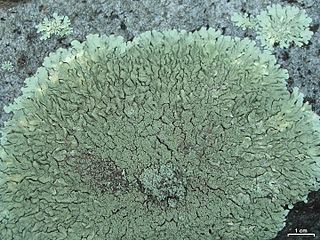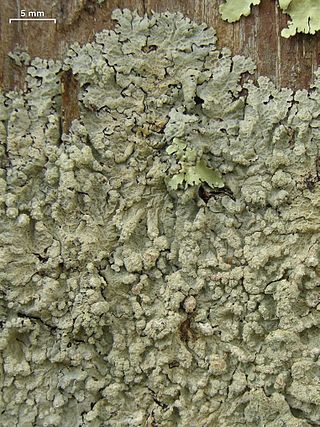
The Parmeliaceae is a large and diverse family of Lecanoromycetes. With over 2700 species in 71 genera, it is the largest family of lichen-forming fungi. The most speciose genera in the family are the well-known groups: Xanthoparmelia, Usnea, Parmotrema, and Hypotrachyna.

Pseudevernia is a genus of foliose lichens in the family Parmeliaceae. The type species of the genus, Pseudevernia furfuracea, has substantial commercial value in the perfume industry.

Xanthoparmelia is a genus of foliose lichens in the family Parmeliaceae. This genus of lichen is commonly found in the United States, as well as Australia, New Zealand and Ecuador.

Xanthoparmelia mexicana, commonly known as the salted rock-shield, is a foliose lichen in the family Parmeliaceae. It grows in 4–10 cm diameter rosettes of gray-green to yellow-green lobes in arid climates all over the world.

Lecanoric acid is a chemical produced by several species of lichen. Lecanoric acid is classified as a polyphenol and a didepside, and it functions as an antioxidant. The acid is named after the lichen Lecanora. The acid has also been isolated from Usnea subvacata, Parmotrema stuppuem, Parmotrema tinctorum,Parmotrema grayana, Xanthoparmelia arida and Xanthoparmelia lecanorica. A related compound, 5-chlorolecanoric acid, is found in some species of Punctelia.
Parmotrema barioense is a species of corticolous lichen in the family Parmeliaceae. The holotype specimen was collected in a Kerangas forest in Sarawak, Malaysia. It has a loosely attached greyish thallus measuring 10–12 cm (3.9–4.7 in) wide, comprising individual lobes 6–20 mm wide. It contains the secondary compounds atranorin, chloroatranorin, protocetraric acid, and butlerin derivatives. The lichen resembles Parmotrema zollingeri, but can be distinguished from that species by the older, convoluted lobes in the centre of the thallus, the larger ascospores, and the presence of butlerins.
Parmotrema abessinicum is a species of corticolous lichen in the family Parmeliaceae. It has been recorded from Africa, Asia, and Oceania.
Parmotrema abnuens is a species of corticolous lichen in the family Parmeliaceae. It was first introduced to science in 1885 as a species of Parmelia by William Nylander in 1885, who described the lichen from samples collected in Uruguay. Mason Hale transferred it to the genus Parmotrema in 1974. The species has also been recorded from Brazil and India.
Parmotrema adspersum is a species of lichen in the family Parmeliaceae. It was originally described as a species of Parmelia by Edvard August Vainio in 1907. John Elix transferred it to Parmotrema in 2002, reasoning that its thick-walled ascospores are typical of that genus. Parmotrema adspersum is common in Thailand and the Philippines.
Parmotrema aldabrense is a species of lichen in the family Parmeliaceae that is found in Africa. It was first described by Carroll William Dodge in 1959 as a species of Parmelia. Mason Hale transferred it to the genus Parmotrema in 1974. The type collection was made in the Aldabra Islands, where it was found growing on tamarind. It has also been recorded from Madagascar. The lichen has an olive-buff coloured thallus measuring up to 14 cm (5.5 in) in diameter.
Parmotrema amboimense is a species of lichen in the family Parmeliaceae that is found in Africa. It was first described by Carroll William Dodge in 1959 as a species of Parmelia. Mason Hale transferred it to the genus Parmotrema in 1974. The type collection was made in Cuanza Sul Province (Angola), where it was found growing at an elevation of 1,000 m (3,300 ft); Dodge also noted the presence of the lichen in Cameroon and Uganda. Parmotrema amboimense has a pale olive-buff coloured thallus measuring up to 10 cm (4 in) in diameter.

Parmotrema mellissii is a widely distributed species of corticolous lichen in the family Parmeliaceae. It was first described by Carroll William Dodge in 1959 as a species of Parmelia. Mason Hale transferred it to the genus Parmotrema in 1974. The type collection was made in Saint Helena. Parmotrema mellissii has a pale yellowish-buff coloured thallus at least 12 cm (5 in) in diameter, comprising rounded lobes about 15 mm wide and long. It has been found in the southern U.S.A., the Neotropics from Mexico to Colombia and Brazil, Africa, Asia, Australia and Oceania.
Parmotrema araucariarum is a species of lichen in the family Parmeliaceae. It was first described scientifically as a species of Parmelia by Austrian botanist Alexander Zahlbruckner in 1909. Mason Hale transferred it to the genus Parmotrema in 1974. The lichen has been reported from Kenya, Tanzania, and South America.

Crespoa is a genus of five species of lichen in the family Parmeliaceae. Species in this genus are characterized by having an upper thallus surface that is wrinkled and reticulately ridged to coarsely foveolate.

Parmotrema rampoddense, commonly known as the long-whiskered ruffle lichen, is a species of foliose lichen in the family Parmeliaceae. It is widely distributed in tropical regions and grows on the bark of oak and palm trees.

Parmotrema arnoldii, commonly known as the powdered ruffle lichen, is a widely distributed species of lichen in the family Parmeliaceae. It has been recorded from Africa, Asia, Europe, Oceania, Macaronesia, and North and South America.

Salazinic acid is a depsidone with a lactone ring. It is found in some lichens, and is especially prevalent in Parmotrema and Bulbothrix, where its presence or absence is often used to help classify species in those genera.
Xanthoparmelia salazinica is a species of lichen in the family Parmeliaceae. Found in South Africa, it was described as a new species in 1989 by American lichenologist Mason Hale. He classified it in Karoowia, a genus that has since been placed in synonymy with Xanthoparmelia following molecular phylogenetic analysis published in 2010.

Parmotrema hypoleucinum is a species of foliose lichen in the family Parmeliaceae. A study of Parmotrema hypoleucinum in Tunisia revealed that it contains atranorin and (+)-iso-usnic acid, chemical compounds of interest for their anti-inflammatory activity. The species was originally scientifically described by Austrian lichenologist Julius Steiner in 1918 as a member of genus Parmelia. Mason Hale transferred it to Parmotrema in 1974.











